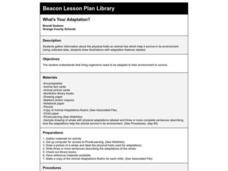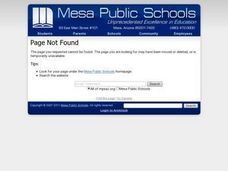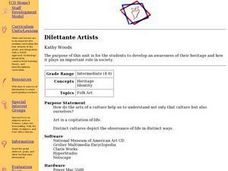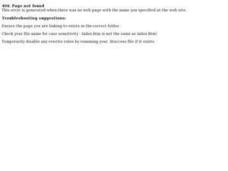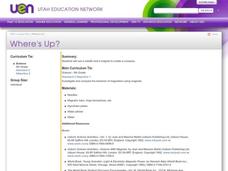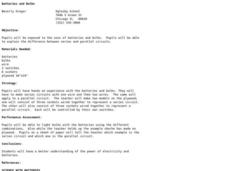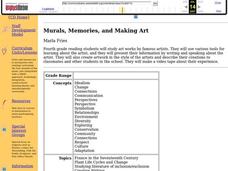Curated OER
Magnetic Attraction
Second graders create a hypothesis on what objects will attract to magnets. In this magnets lesson plan, 2nd graders use a computer program to create a hypothesis as to what will attract or unattract magnets. For an extension, they test...
Curated OER
Cast of Characters Lesson Plan: Comparing Artists
Students choose an artist, examine a painting, read a statement of the artist and their biography. They research the artist using the World Wide Web, books, encyclopedias, art, prints or magazines. They write an essay using their notes.
Curated OER
Color Story
Students listen to a teacher-created story and practice using color words with a word processing program. This lesson has a video explanation and an AppleWorks example of a teacher-created story.
Curated OER
What's Your Adaptation?
Second graders gather information about the physical traits an animal has which help it survive in its environment. Using collected data, 2nd graders draw illustrations with adaptation features labeled.
Curated OER
Desert Animal Presentations
Fourth graders assemble a presentation about a desert animal using presentation software and a teacher-created template.
Curated OER
Education and Self Determination
Students read and discuss a section from Encyclopedia of North American Indians. They select and locate various sources to red/listen to and take notes on.
Curated OER
Dilettante Artists
Students investigate their personal heritage. They research and record iand organize nformation in journal notes. Students create folk art using a variety of techniques and media.
Curated OER
Time Train
Learners are read a short book "Time Train" by Paul Fleischman. Using the text, they identify the clues to let them know the train is traveling back in time. They make a time line of the trip and make a cutout of meat-eating and...
Curated OER
What Was It Like?
Students use the Internet to gather historical facts about the county in which they live. Using the information, they discover how to check it for accuracy and present their findings to the class. They write an essay about the history of...
Curated OER
Where's Up?
Fifth graders brainstorm answers to the question why compasses point north. In groups, they use introduce the needle to the different ends of the magnet. They place the needles in a styroform disk and record their results in their...
Curated OER
Batteries and Bulbs
Students examine the uses of batteries and bulbs and explain the differences between series and parallel circuits. In this circuits lesson students complete a lab activity.
Curated OER
Sense-Ability
Students use comparisons, graphing, patterning, and sorting, and develop language skills as they explore the five senses.
Curated OER
Discovery Channels
Young scholars read a New York Times article in order to explore issues about the celebration of Columbus Day. They, working in groups, research the legacy of exploration and colonization. They use the research to create a first person...
Curated OER
Famous Americans Presentation
Fifth graders research a famous American; then do a presentation using Hyper-Studio, ClarisWorks or Power-Point.
Curated OER
Arizona Historical Persons Scavenger Hunt
Fourth graders use a research site directory and a scavenger hunt worksheet to locate information on early explorers and settlers in Arizona.
Curated OER
Touring My County
Second graders research important events that occurred in their counties for each year they have been alive. They, in groups, categorize these events and develop notes to be used in the writing of an autobiography.
Curated OER
Farming the Southern Colonies
Seventh graders investigate the basis for farming choices in the early colonies by using group research and discussion. Each group researches a topic that they write about and present to the rest of the class.
Curated OER
'My Town' Brochure
Ninth graders use the internet to research a city or town on the "Walk Across Texas" route. They create a brochure or booklet advertising their assigned city or town.
Curated OER
Centennial: What's in a Name: Utah
Fourth graders research the possible sources for the origin of the name 'Utah'. They discover that printed information can still be disputed and use multiple sources as they list various possibilities for the name origin.
Curated OER
Murals, Memories, and Making Art
Fourth grade reading students study art works by famous artists. They use various tools for learning about the artist, and they present their information by writing and speaking about the artist. They also create artwork in the style of...
Curated OER
Murals, Memories, and Making Art
Fourth graders examine the life and works of famous artists. Using the internet, they take notes and present their information to the class in an oral presentation. They create their own original artwork in the same style of their...
Curated OER
The Path of Pollution
Students conduct a brainstorming exercise that asks them to list all the ideas about air pollution that can be recalled. The ideas are recorded on a chart that the teacher has prepared. The lesson contains sufficient background...
Curated OER
Creating a World of Peace at Home and Abroad
Students are introduced to the various lives of children in other countries. Using current events, they compare and contrast the events in America with that of the country they chose. They review the importance of peace and the spirit...
Curated OER
Around the World Calendar
Young scholars explore a country and its culture through its national landmarks. They use technology tools to research and communicate information. To demonstrate research skills, they use the Internet as well as print materials.
Other popular searches
- Using an Encyclopedia Index
- Teach Using Encyclopedia
- Using an Encyclopedia Page
- Using Encyclopedia Lessons



